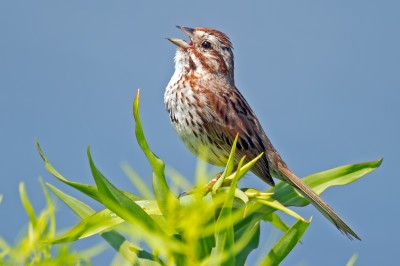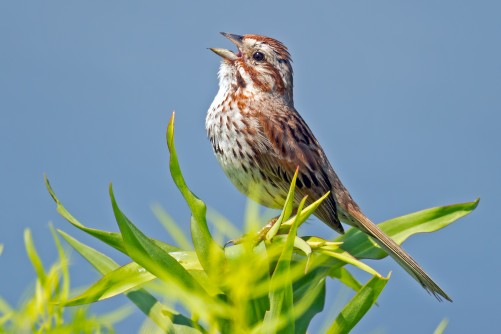Newswise — Whole genome sequencing of North American song sparrows has revealed the genetic underpinnings for a stunning range of body sizes found throughout the bird’s westernmost range—an adaptation that may make the birds more resilient to climate change. This work is the first output from a larger research effort to sequence song sparrow genomes from across North America, spanning nearly all of the 25 recognized subspecies.
The current research is published in Nature Communications by scientists from the University of British Columbia, the Cornell Lab of Ornithology, Ouachita Baptist University, and the University of Alaska Fairbanks.
The study offers support for Bergmann’s Rule, which broadly states that among organisms that regulate their own heat, natural selection in colder climates leads to larger-bodied organisms while warmer climates lead to smaller bodies. Larger bodies are more efficient at retaining heat. Smaller bodies allow an organism to stay cooler.
“We found eight gene variations in the genomes we sequenced, all associated with body mass as predicted by Bergmann’s Rule,” said lead author Katherine Carbeck, a Ph.D. candidate at the University of British Columbia in Vancouver. “What this tells us is that there is a genetic basis for song sparrow adaptation to local climate conditions, stretching from the coldest locations in the far north to the warmest parts of its range in California.”
Song sparrows that live year-round on Alaska’s Aleutian Islands can be up to three times larger than their cousins near San Francisco Bay.
“The size difference among song sparrows is wild to even think about,” said researcher Jennifer Walsh at the Cornell Lab of Ornithology. “Our results show that song sparrows have substantial capacity for adapting to local environmental change and the genetic mechanisms underlying those changes are quite clear. We thought there would be a more complicated genetic component, or many more genes working together, to create the huge size difference.”
For this study, the researchers sequenced and compared 79 genomes from 9 song sparrow subspecies originating from multiple locations, work done at the Fuller Evolutionary Biology Program at the Cornell Lab of Ornithology. Tissue samples used for this study came from specimens held by the University of Alaska Museum of the North, collected between 1997 and 2000, along with previously published whole genomes for California subspecies. Song sparrows are an especially useful study species because they are so widespread and are adapted to live in so many different types of environments.
“We tend to think of evolution as occurring over millions of years, but microevolutionary processes—changes taking place over a short period of time–play a crucial role in helping song sparrows survive even in novel climate conditions,” Carbeck said.
Peter Arcese, a co-author and professor in UBC’s department of forest and conservation sciences, and collaborator with Walsh and Carbeck, says the findings suggest a resilient future for these birds.
“Our findings imply that some, if not all, locally adapted song sparrow populations may continue to adapt to climate change, as long as we maintain habitat conditions that facilitate the movement of individuals and genes between populations,” he said.
According to the scientists, understanding the nuances of microevolution makes a difference when it comes to conservation. For example, song sparrows in northwestern regions, such as Alaska and British Columbia, show stable or increasing populations currently, but the opposite is true for populations along the West Coast of the continental United States, with some San Francisco Bay populations listed at the state level as threatened. Declines in one portion of the range could mean loss of genetic diversity in locally specialized populations, despite the overall trends for the species. And though song sparrows have been shown to be very adaptable to local climates, there is a limit.
“Although micro-evolution has the potential to partly offset the effects of climate change,” Carbeck said. “the key question is whether local adaptation can keep pace with the speed at which overall climate change is happening.”
Project funding was provided by The Natural Sciences and Engineering Research Council of Canada, University of British Columbia, U.S. National Science Foundation, and a Hesse fellowship and research award to K. Carbeck.
MEDIA CONTACT
Register for reporter access to contact detailsArticle Multimedia

Credit: Brian E. Kushner, courtesy Cornell Lab of Ornithology.
Caption: Song sparrows appear to adapt to local climate conditions across their vast range.

Credit: Artwork by Jillian Ditner, Cornell Lab of Ornithology.
Caption: Song sparrow that live in the coldest part of their range (far left) can be up to 300% larger than those in warm climates (far right).


